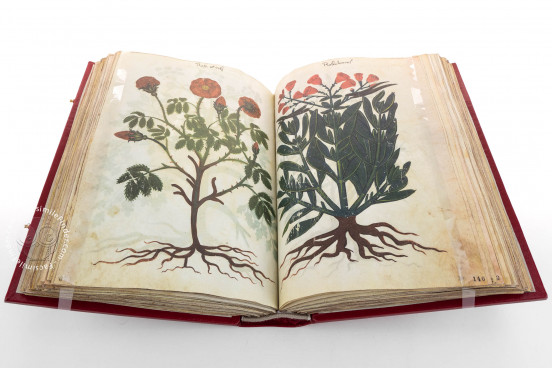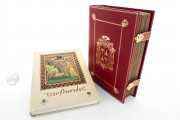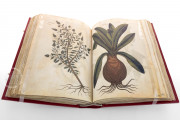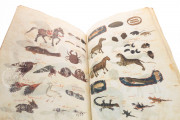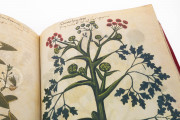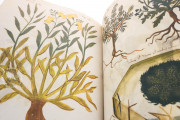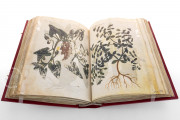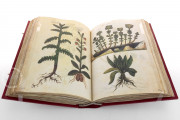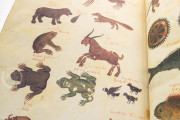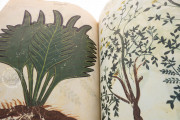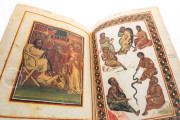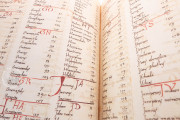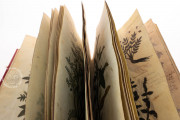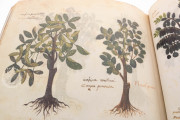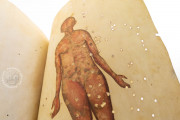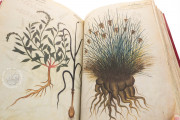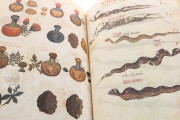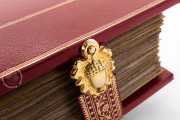The Greek Dioscorides is a picture book herbal—a book of medicinal plants—made in Constantinople in the first half of the fifteenth century, with much of its imagery copied directly from a late antique illuminated manuscript. 412 of its pages are given over to images of plants, most of which occupy a full page. There follow twenty-five pages devoted to animals and birds, grouped many to a page. The manuscript concludes with two miniatures dedicated to human anatomy (fols. 237v and 239r). Its four full-page miniatures depict luminaries of ancient Greek medicine and pharmacology.
The Greek Dioscorides—also confusingly known as the Greco-Latin Dioscorides—is named for the language of the first series of labels identifying the subjects of the illustrations and for the ancient Greek physician Dioscorides Pedanios, whose treatise on pharmacology provided the source for many of the manuscript's illustrations.
A Revered Manuscript as Exemplar
The principal inspiration for the Greek Dioscorides was the sixth-century Vienna Dioscorides, a compendium of ancient Greek natural history texts made for a Byzantine princess. Not only were many of the naturalistic vignettes of the fifteenth-century picture book copied from the earlier manuscript, but the frontispieces to the earlier book were copied, although they appear near the end of the fifteenth-century book (fols. 233r, 234v-235r, and 236v).
A Testament to Ancient Pharmacological Knowledge
Two of the full-page miniatures focus on Dioscorides. In one, he is shown seated, his text in the form of a roll in his left hand (fol. 234v). He reaches out to the personification of Discovery, who is offering him a mandrake root, presumably harvested by the leased dog that accompanies her.
In the second miniature, Dioscorides is shown writing, the personification of intelligence at his elbow (fol. 236). Intelligence holds out a mandrake root, and an artist is at work painting the plant from nature. Together, these two miniatures emphasize the value of gathering specimens and recording their appearance.
Isidore of Kyïv Makes His Mark
The labels in cursive Greek Minuscule identifying the subjects of the naturalia have been attributed to Isidore of Kyïv (d. 1463), a Christian prelate who held positions in the Orthodox and Latin Churches. It is unclear whether he wrote them as a part of the manuscript's original production or added them not long after the creation of an entirely textless picture book. Later writers added labels in Latin.
Identifiable Plants
Whether or not the plants were originally labeled, they could have been easily identified thanks to the detailed renderings. Many of the vignettes are as large or larger than life, and—even though copied from earlier manuscripts—share the revealing naturalism of their models. Furthermore, as is common in herbals, not only the leaves and flowers but also the root systems are pictured.
Creatures Great and Small
There is a shift in approach when the manuscript turns to the subject of animals. Many creatures—as many as eighteen—are grouped onto a single page without any regard for relative scale, creating some comical effects (for example, on the page with a horse and a variety of sea creatures; fol. 222v). The focus in this section is on poisons, so there are a great number of snakes and scorpions.
In the Collection of Fabio Chigi
The manuscript was probably in Italy by 1511, when the Latin-language index was added (fols. 1-10). The manuscript probably entered the collection of Fabio Chigi (1599-1667; later Pope Alexander VII) before he was appointed cardinal in 1652: the coat of arms stamped in gold on the front and back covers are those of a bishop (featuring a cardinal's hat with six tassels on each side of the crest). The Chigi manuscripts entered the Vatican collection in 1923.
We have 1 facsimile edition of the manuscript "Greek Dioscorides": Dioscórides Grecolatino del Papa Alejandro VII facsimile edition, published by Testimonio Compañía Editorial, 1999
Request Info / Price
